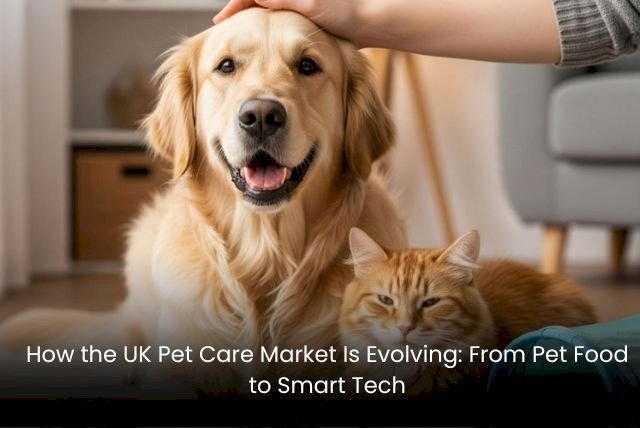How the UK Pet Care Market Is Evolving: From Pet Food to Smart Tech
Explore how the UK pet care market is evolving in 2025 — from premium pet food and wellness trends to smart technology and sustainable innovations.

In 2025, British households are spending more than ever on their pets — from gourmet food subscriptions to AI-powered collars. As lifestyles evolve, the UK pet care market has become one of the country’s fastest-growing consumer sectors, blending compassion, technology, and sustainability in remarkable ways.
Once focused mainly on feeding and grooming, today’s industry embraces pet wellness, digital innovation, and ethical consumerism. From organic diets to smart tracking devices, pet care in the UK reflects not only changing lifestyles but also the deepening emotional bond between people and their animals.
According to Statista, the UK pet care market was valued at approximately £6.7 billion in 2024 and is projected to grow at a compound annual growth rate (CAGR) of 5.4% through 2033. This steady rise reflects the nation’s enduring love for pets and its willingness to invest in their wellbeing.
Pet Food: The Heart of the UK Pet Care Industry

Image source: pinterest.com
Pet food remains the foundation of the UK pet care market, accounting for nearly 40% of total industry revenue. British pet owners are increasingly spending on high-quality, health-focused food as part of the broader “humanisation of pets” movement.
Premiumisation of Pet Nutrition
According to the Pet Food Manufacturers’ Association (PFMA), 62% of UK households now own at least one pet. With this growing ownership base, demand for natural, grain-free, and functional diets continues to rise.
Key trends include:
-
Natural and organic ingredients: Brands such as Lily’s Kitchen, Scrumbles, and Butternut Box focus on locally sourced, human-grade products.
-
Alternative proteins: Insect-based and plant-based foods are gaining traction among eco-conscious owners.
-
Functional nutrition: Recipes formulated for joint care, digestion, or skin health are now common.
-
Subscription models: Services like Tails.com and Butternut Box offer convenient, personalised meal deliveries.
Pet food is no longer a commodity — it’s a lifestyle choice reflecting owners’ own health and sustainability values.
Pet Health, Wellness, and Veterinary Innovation

Image source: pinterest.com
Modern British pet owners treat their animals as family, driving the wellness revolution across the UK pet care market.
Preventative Care Becomes Mainstream
Routine health checks, dental plans, and early diagnostics are becoming standard, as owners seek to extend pets’ lifespans. Nutritional supplements such as probiotics, vitamins, and omega-3 oils are increasingly purchased online.
According to Mintel’s 2025 Pet Wellness Report, more than 70% of owners consider preventative care essential to their pet’s wellbeing.
The Rise of Pet Insurance and Telehealth
The Association of British Insurers (ABI) reports that over 4.2 million UK pets are now covered by insurance — a record high. This financial safety net allows for better treatment access and contributes to industry growth.
Digital transformation has also reached veterinary care. Platforms like Joii Pet Care and PawSquad now provide video consultations and digital health records. This innovation improves access and reduces stress, especially for anxious animals or rural owners.
Grooming, Pampering, and Lifestyle Services

Image source: pinterest.com
The UK’s grooming and luxury pet service industry is booming, particularly in urban centres such as London, Manchester, and Edinburgh.
The Rise of Pet Lifestyle Culture
Social media has played a key role in popularising “pet pampering.” Instagram and TikTok trends have driven growth in pet fashion, photography, and grooming.
Leading trends include:
-
Boutique salons and pet spas: Aromatherapy baths, coat treatments, and styling sessions.
-
Mobile grooming vans: Offering convenience for time-poor pet owners.
-
Subscription boxes: BusterBox and Pawsomebox deliver toys, treats, and grooming items monthly.
Millennials and Gen Z pet owners, who dominate new ownership, are willing to pay more for premium experiences that reflect their own lifestyle standards.
E-commerce and Subscription Models Transforming Pet Retail
The UK pet care market has undergone a significant digital shift since 2020. Online retail now accounts for a growing share of all pet product sales.
E-commerce Growth in Pet Retail
-
Over half of UK pet owners purchase products online at least monthly (Statista 2025).
-
Retailers like Pets at Home, Fetch by Ocado, and Jollyes have expanded e-commerce operations.
-
Subscription-based auto-deliveries are becoming mainstream for essentials such as food, litter, and supplements.
Artificial intelligence and data analytics now power personalised shopping recommendations, with product suggestions based on breed, health, and activity data.
This evolution makes pet retail more convenient, data-driven, and customer-centric — trends expected to accelerate through the next decade.
Smart Tech: The Digital Evolution of Pet Care

Image source: pinterest.com
Technology has become the defining innovation in the UK pet care market. The rise of pet tech combines data, connectivity, and convenience to create safer and healthier lifestyles for animals.
Key Innovations in UK Pet Tech
-
GPS trackers and smart collars: PitPat (UK-based) and Tractive offer real-time monitoring of pets’ location and activity.
-
Smart feeders and hydration systems: Automate meal times and portion control.
-
AI-powered pet cameras: Devices like Furbo and Petcube let owners interact with pets remotely.
-
Wearables for health tracking: Record vital signs, rest patterns, and movement data.
According to Euromonitor International, the UK accounts for a growing share of Europe’s £2 billion pet tech market, driven by consumers who value both safety and insight.
Experts predict that by 2030, AI and IoT integration will allow vets to monitor pets’ health remotely, revolutionising early diagnosis and preventative care.
Sustainability and Ethical Pet Care
Sustainability has become a defining characteristic of modern British consumerism — and pet care is no exception.
Eco-Conscious Pet Ownership
A Mintel UK survey (2025) found that 42% of pet owners now prioritise sustainability when choosing products. This shift has given rise to brands that combine ethical sourcing with environmental responsibility.
Emerging eco trends include:
-
Sustainable pet food: Brands like Yora and Scrumbles use insect protein to lower carbon impact.
-
Recyclable packaging: Companies are reducing single-use plastics with refillable solutions.
-
Carbon-neutral logistics: Startups are offsetting delivery emissions.
Sustainability is no longer a niche preference — it’s a purchasing priority for the modern UK pet owner.
Challenges Facing the UK Pet Care Market
Despite impressive growth, the UK pet care industry faces key challenges that could shape its future direction.
Rising Costs and Supply Chain Pressures
Inflation and high manufacturing costs are affecting food prices and veterinary services. Brands are responding by localising production and offering smaller, affordable product lines.
Regulatory Oversight and Welfare
New DEFRA and FSA regulations on labelling and pet welfare are tightening standards, ensuring higher transparency. While beneficial, compliance increases costs for smaller businesses.
Environmental and Social Concerns
Post-pandemic, overcrowded shelters and “pandemic pet abandonment” remain concerns. Non-profits are urging responsible ownership and government-backed adoption campaigns.
Market Segmentation: Where Growth Is Happening
| Segment | Share (Approx.) | Growth Driver |
|---|---|---|
| Pet Food | 40% | Premiumisation, organic diets |
| Veterinary & Health | 25% | Preventative care, tele-vet |
| Grooming & Accessories | 15% | Luxury and personalised products |
| Pet Insurance | 10% | Awareness and affordability |
| Pet Tech & E-commerce | 10% | Smart devices, online retail |
This segmentation illustrates how technology, health, and lifestyle trends together fuel market growth.
Business and Investment Opportunities
The UK pet care market presents strong opportunities for startups and investors in multiple areas:
-
Pet tech: Smart collars, AI monitoring, automated feeders.
-
Sustainability: Eco-friendly packaging, low-carbon food production.
-
Wellness and supplements: Preventative health and nutrition.
-
Services: Grooming franchises, daycare centres, and digital vet platforms.
With emotional value and consistent consumer spending, the sector remains resilient even amid economic uncertainty.
Future Outlook: 2025–2033
Looking ahead, the UK pet care market is projected to exceed £11 billion by 2033 (Statista, 2025). Continued innovation and digital adoption will define this decade of growth.
Key Forecasts
-
AI-integrated health systems: Real-time vet monitoring and diagnostics.
-
DNA and genetic health testing: Preventative healthcare driven by personalised insights.
-
Circular manufacturing: Sustainable, closed-loop packaging solutions.
-
Pet-inclusive design: Housing and hospitality sectors increasingly accommodating pets.
Industry experts predict that technology will not replace empathy — it will amplify it. As human–animal bonds strengthen, innovation will follow love, not just profit.
Conclusion: Britain’s Evolving Bond With Its Pets
The UK pet care market in 2025 captures a nation where pets are companions, not commodities. The rise of smart tech, sustainable brands, and preventative healthcare shows how far the industry has evolved.
British pet owners are redefining what it means to care responsibly — balancing convenience, compassion, and innovation.
At Briton News, we believe this transformation is more than an economic trend; it reflects the very heart of British life — caring, connected, and continually evolving.
FAQs – Understanding the UK Pet Care Market in 2025
1. How big is the UK pet care market in 2025?
According to Statista, the UK pet care market is valued at around £6.7 billion in 2024 and is projected to grow at a compound annual rate of 5.4% through 2033. This growth is driven by rising pet ownership, premiumisation, and advances in smart pet technology.
2. What are the main factors driving growth in the UK pet care industry?
The key growth factors include increasing pet ownership, digital transformation, demand for healthier food, and the humanisation of pets. The rise of e-commerce, tele-vet platforms, and smart tech devices has also reshaped how British consumers care for their pets.
3. Which segments dominate the UK pet care market?
The largest segment is pet food, making up about 40% of the market. Other major sectors include veterinary health, pet insurance, grooming services, and pet technology, each contributing to the industry’s expanding value.
4. What is the biggest trend in the UK pet care market right now?
One of the most significant trends is the integration of smart technology — from GPS collars to AI-powered feeders and health trackers. This reflects the growing demand for convenience, real-time monitoring, and data-driven care among UK pet owners.
5. How is sustainability shaping the UK pet care industry?
Sustainability has become a major purchasing factor. UK brands are investing in eco-friendly packaging, insect-based pet food, and carbon-neutral supply chains. Over 40% of British pet owners now prefer sustainable or recyclable pet products, according to Mintel.
6. Why is pet insurance becoming more popular in the UK?
Pet insurance uptake is rising due to higher veterinary costs and greater awareness of financial protection. The Association of British Insurers reports that over 4.2 million UK pets are now insured — the highest level ever recorded.
7. What is pet tech, and how is it changing the UK market?
Pet tech refers to smart devices and digital solutions that help owners monitor, feed, or interact with their pets. Popular examples include GPS trackers, smart feeders, and health-monitoring wearables. The UK is a leading European market for these innovations.
8. How are e-commerce and subscriptions changing pet care in the UK?
Online shopping has transformed the UK pet retail sector. More than half of pet owners now buy supplies online through platforms like Pets at Home, Fetch by Ocado, and Jollyes. Subscription models for pet food and treats are also on the rise due to their convenience.
9. What challenges does the UK pet care market face in 2025?
The sector faces several challenges, including rising vet costs, supply chain disruptions, regulatory changes, and environmental concerns. However, innovation in local sourcing, digital health, and sustainable production is helping the market remain resilient.
10. What does the future look like for the UK pet care market?
The future of the UK pet care market will be shaped by technology, sustainability, and personalised care. By 2033, analysts predict the market could exceed £11 billion, led by AI-driven health tools, smart products, and growing investment in pet wellness.

















